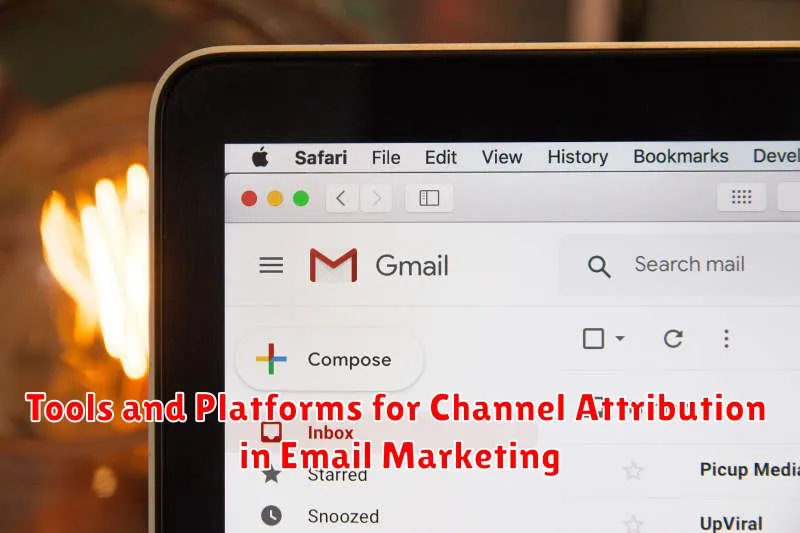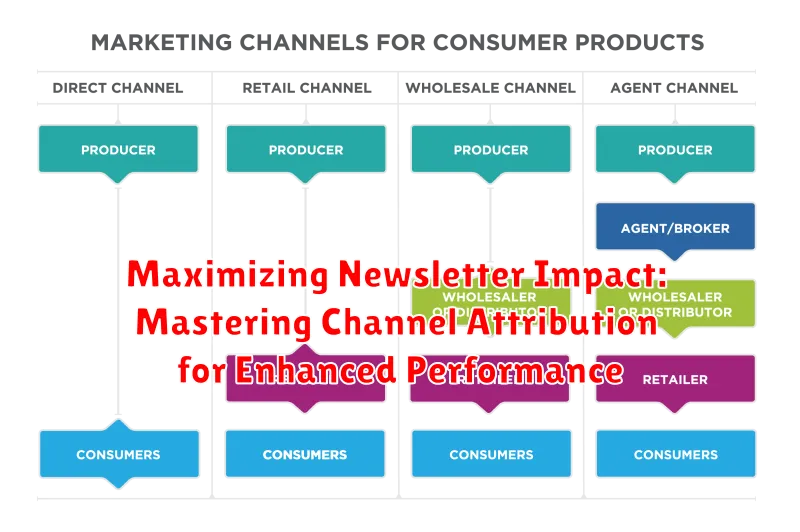In the ever-evolving landscape of digital marketing, newsletters remain a potent tool for engaging audiences and driving conversions. However, simply sending out compelling content is no longer enough. To truly maximize newsletter impact, marketers must understand which channels are contributing most effectively to their success. This understanding hinges on mastering channel attribution, a critical process that allows you to identify the source of your newsletter subscribers and their subsequent actions.
This article delves into the essential strategies for mastering channel attribution in newsletter marketing. We will explore various methods for accurately tracking where your subscribers originate, from social media platforms and search engines to website forms and offline campaigns. By implementing robust attribution models, you can gain invaluable insights into the performance of your different marketing channels, enabling data-driven decisions that optimize your newsletter strategy and ultimately lead to enhanced performance and a stronger return on investment.
Understanding Channel Attribution in Newsletter Marketing
In the realm of newsletter marketing, channel attribution plays a pivotal role in understanding the effectiveness of different marketing channels that lead subscribers to your newsletter. It is the process of identifying which touchpoints or interactions a customer had before subscribing to your newsletter, and assigning credit to those touchpoints for the conversion (in this case, newsletter signup).
Essentially, it answers the question: “What marketing activities contributed to someone joining our newsletter list?” This understanding is crucial for optimizing marketing spend and focusing on the most effective channels.
Without proper channel attribution, you might be over- or under-investing in certain marketing channels. Accurately attributing newsletter sign-ups to their source allows you to make data-driven decisions about where to allocate your marketing resources for maximum impact. This can lead to improved ROI and a more efficient marketing strategy.
Why is Channel Attribution Important for Newsletters?
Channel attribution is crucial for newsletter marketing because it provides insights into the effectiveness of various channels in driving conversions and achieving specific goals. Without accurate attribution, it’s difficult to determine which channels are contributing the most to your newsletter’s success.
By understanding which channels are responsible for driving subscribers, opens, clicks, and ultimately conversions (e.g., purchases, sign-ups), marketers can:
- Optimize marketing spend by allocating resources to the most effective channels.
- Improve targeting by understanding where valuable subscribers are coming from.
- Refine messaging to resonate with specific audiences on different channels.
- Enhance overall campaign performance by identifying areas for improvement and replication.
Ultimately, channel attribution enables data-driven decision-making, leading to a more efficient and impactful newsletter strategy.
Different Models of Channel Attribution: First-Touch, Last-Touch, and More
In the realm of channel attribution, understanding the various models is critical for accurate performance assessment. Each model offers a different perspective on how credit should be assigned to marketing touchpoints that lead to a conversion.
First-Touch Attribution: This model attributes 100% of the credit to the very first touchpoint a customer interacts with. It’s valuable for understanding initial brand awareness.
Last-Touch Attribution: Conversely, this model gives 100% of the credit to the final touchpoint before a conversion. It’s useful for evaluating the effectiveness of your last marketing efforts before the customer took action.
Beyond these, other models exist, including:
- Linear Attribution: Credit is evenly distributed across all touchpoints in the customer journey.
- Time-Decay Attribution: More credit is given to touchpoints closer to the conversion.
- U-Shaped (Position-Based) Attribution: Assigns the most credit to the first and last touchpoints, with the remainder distributed among the others.
Multi-Touch Attribution: A Comprehensive Approach
Multi-touch attribution acknowledges that a customer’s journey often involves multiple interactions with your newsletter before they convert. Instead of assigning all the credit to a single touchpoint, it distributes the value across various touchpoints.
This approach offers a more comprehensive understanding of which elements of your newsletter strategy are truly contributing to success. By understanding the value of each touchpoint, marketers can better optimize their campaigns.
Several multi-touch attribution models exist, including:
- Linear Attribution: Distributes credit evenly across all touchpoints.
- Time-Decay Attribution: Assigns more credit to touchpoints closer to the conversion.
- Position-Based Attribution: Allocates a percentage of credit to the first and last touchpoints, with the remaining credit distributed among the others.
Choosing the right model depends on your business goals and customer behavior. Implementing multi-touch attribution can provide invaluable insights into optimizing your newsletter strategy for maximum impact.
Tracking Newsletter Performance: Key Metrics to Consider
To effectively gauge the impact of your newsletter campaigns and optimize channel attribution, it is crucial to monitor several key metrics. These metrics provide insights into audience engagement, conversion rates, and overall campaign effectiveness.
Open Rate: This metric reflects the percentage of recipients who opened your email. A higher open rate indicates a compelling subject line and relevant content.
Click-Through Rate (CTR): The CTR measures the percentage of recipients who clicked on a link within your email. It demonstrates the effectiveness of your calls to action and the relevance of your content to the audience.
Conversion Rate: This metric tracks the percentage of recipients who completed a desired action, such as making a purchase or filling out a form, after clicking a link in your email. It directly reflects the effectiveness of your newsletter in driving business results.
Bounce Rate: Monitoring both hard and soft bounce rates is critical for maintaining a healthy email list and ensuring deliverability.
Unsubscribe Rate: A consistently high unsubscribe rate may indicate issues with content relevance, frequency, or targeting.
Using Google Analytics for Newsletter Channel Attribution

Google Analytics is a powerful tool for understanding how your newsletter contributes to your overall website traffic and conversions. By properly configuring Google Analytics, you can gain valuable insights into the effectiveness of your newsletter campaigns.
To effectively use Google Analytics for newsletter attribution, it is crucial to:
- Set up Goals: Define clear goals within Google Analytics that align with your newsletter objectives (e.g., form submissions, product purchases).
- Implement UTM Parameters: Use UTM parameters in your newsletter links to track the source, medium, and campaign associated with each click (detailed in the next section).
- Analyze Reports: Explore the Acquisition reports in Google Analytics to identify the traffic originating from your newsletters. Pay attention to metrics like bounce rate, session duration, and conversion rate.
By tracking these metrics, you can directly attribute website behavior and conversions to users who interacted with your newsletter, providing a clear view of its contribution to your business goals.
Implementing UTM Parameters for Accurate Tracking
UTM (Urchin Tracking Module) parameters are crucial for accurately tracking the performance of your newsletter campaigns within analytics platforms like Google Analytics. These parameters are tags you add to the end of your newsletter URLs to identify the source, medium, campaign name, and other dimensions of your traffic.
By implementing UTM parameters, you can distinguish newsletter traffic from other sources, such as organic search or social media. This allows you to attribute conversions and other key metrics directly to your newsletter efforts.
Here’s a breakdown of the common UTM parameters:
- utm_source: Identifies the source of the traffic (e.g., “newsletter”).
- utm_medium: Identifies the marketing medium (e.g., “email”).
- utm_campaign: Identifies the specific campaign or promotion (e.g., “summer_sale”).
- utm_term: Identifies paid search keywords (if applicable).
- utm_content: Differentiates ads or links within the same campaign.
Carefully plan your UTM parameter naming conventions and maintain consistency to ensure clean and reliable data in your analytics reports. Utilize URL builders to streamline the process and minimize errors.
Analyzing Attribution Data to Optimize Newsletter Strategy
Once attribution data is collected, the crucial next step involves rigorous analysis to derive actionable insights. This process allows marketers to understand which channels are most effective at driving desired newsletter outcomes, such as subscriptions, website visits, or conversions.
The analysis should focus on identifying patterns and trends within the data. For example:
- Which UTM parameters consistently lead to higher open rates?
- Which referring sources result in the most engaged subscribers?
- What is the average conversion rate for users who interact with the newsletter via different channels?
By answering these questions, marketers can refine their newsletter strategy. For example, increased investment can be allocated to high-performing channels, while resources can be reallocated from underperforming ones. A/B testing of different subject lines, content formats, and calls-to-action, guided by attribution insights, can further optimize newsletter performance.
Tools and Platforms for Channel Attribution in Email Marketing

Several tools and platforms are available to facilitate channel attribution in email marketing. These platforms provide varying degrees of sophistication, enabling marketers to track and analyze the effectiveness of different channels in driving newsletter sign-ups, engagement, and conversions.
Marketing Automation Platforms such as HubSpot, Marketo, and Pardot offer robust attribution features that can be integrated with email marketing campaigns. These platforms often include built-in tracking capabilities and reporting dashboards to visualize attribution data.
Analytics Platforms like Google Analytics and Adobe Analytics can also be leveraged for channel attribution. By implementing UTM parameters correctly, you can track which channels are driving traffic and conversions from your newsletters.
Specialized attribution software solutions, such as Ruler Analytics or Windsor.ai, provide advanced features for multi-touch attribution and cross-channel tracking. These platforms often integrate with various marketing tools to provide a comprehensive view of the customer journey.
The choice of tool will depend on your specific needs, budget, and the complexity of your marketing strategy. Carefully evaluate the features and capabilities of each platform before making a decision.
Best Practices for Improving Channel Attribution Accuracy
Achieving accurate channel attribution in newsletter marketing requires meticulous planning and consistent execution. By implementing these best practices, marketers can gain a clearer understanding of which channels are driving conversions and optimize their strategies accordingly.
Consistent UTM Parameter Usage
UTM parameters are crucial for tracking the source of traffic. Ensure all links within your newsletter, regardless of the destination, are tagged with consistent and descriptive UTM parameters. This includes campaign source, medium, and name.
Regular Audits of Tracking Implementation
Conduct routine audits of your UTM parameter implementation. Check for errors in tagging, inconsistencies in naming conventions, and broken links. This proactive approach can prevent data inaccuracies and ensure reliable attribution data.
Data Integration and Centralization
Consolidate data from various platforms, such as your email marketing platform and Google Analytics, into a centralized reporting system. This enables a holistic view of customer interactions and prevents data silos, which can lead to inaccurate attribution.
Refine Attribution Models Based on Performance
Don’t rely solely on a single attribution model. Experiment with different models to identify the one that best reflects the customer journey. Continuously analyze the performance of each model and adjust your approach as needed.

